History
The current emblem is based on the one adopted in 1998 along with the city flag, at the 16th session of the Maslihat of Astana in 1998. [3] In 2019 the city was renamed from Astana to Nur-Sultan. As the city name features on both the emblem and city flag, both insignia were updated to the new name in 2019.
Under the Russian Empire, the coat of arms featured a stylized castle on a turquoise shield. That design had several variations, with one featured leaves, while the other featured ears of cereal. The crown also varied with one version using a monarchical crown, while the other used a mural crown.
During Soviet era, the city was known as Tselinograd. It was primarily represented by a "full hands" design, which symbolized agriculture.
After the dissolution of the Soviet Union, the city was renamed from Teslinograd to Akmola and later to Astana. For the first few years after becoming the capital of an independent Kazakhsta, the city did not have an official coat of arms. Instead, it used an unofficial design featuring a medieval wall and ancient warlord superimposed on a blue shield.
The emblem the city used between 1998-2008 showed a mythical creature standing in front of a medieval fortification, flanked by ears of wheat. [4] [5]

Nur-Sultan, originally known as Akmolinsk, Tselinograd, and most recently Astana, is the capital city of Kazakhstan. The city acquired its present name on 23 March 2019, following a unanimous vote in Kazakhstan's parliament. It was named after Nursultan Nazarbayev, President of Kazakhstan from 1990 to 2019.

Nursultan Abishuly Nazarbayev or Nursultan Abishevich Nazarbayev is a Kazakh politician who served as the first President of Kazakhstan, in office from 24 April 1990 until his formal resignation on 20 March 2019, and as the Chairman of the Security Council of Kazakhstan from 21 August 1991 to 5 January 2022, holding the title Elbasy since 14 June 2010. He was one of the longest-ruling non-royal leaders in the world, having led Kazakhstan for nearly three decades, excluding chairmanship in the Security Council after the end of his presidency. He was named First Secretary of the Communist Party of the Kazakh SSR in 1989 and was elected as the nation's first president shortly before its independence from the Soviet Union.

The tenge is the currency of Kazakhstan. It is divided into 100 tiyn. The ISO-4217 code is KZT.

The president of the Republic of Kazakhstan is the head of state of the Republic of Kazakhstan and the commander-in-chief of the Armed Forces of the Republic of Kazakhstan. The president is the holder of the highest office within the Republic of Kazakhstan. The powers of this position are described in a special section of the Constitution of Kazakhstan.

Nursultan Nazarbayev International Airport is an international airport in the Akmola Region, Kazakhstan. It is the primary international airport serving Nur-Sultan, the capital city of Kazakhstan. The airport is the second-busiest international air passenger gateway into Central Asia, the 13th busiest airport in the Post-Soviet states and the second-busiest airport in terms of passenger traffic in Kazakhstan, with 5,099,391 passengers in 2019.
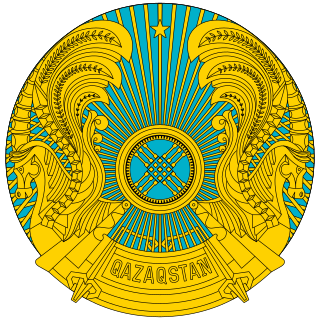
The emblem of Kazakhstan was adopted on June 4, 1992. The designers of the emblem are Jandarbek Melibekov and Shota Walikhanov. About 245 projects and 67 description designs of the future arms took part in the final competition. Like other post-Soviet republics whose symbols do not predate the October Revolution, the current emblem retains some components of the Soviet one, in this case, rising sun rays and star. Prior to 1992, Kazakhstan had an emblem similar to all other Soviet Republics.
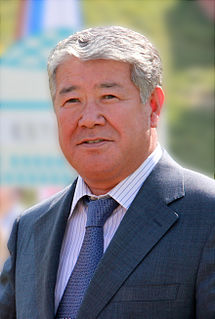
Ahmedjan Smagululy Yessimov is a Kazakh politician who's served as the chairman of Samruk-Kazyna from 2017 to 2021. Prior to that, he was the director of Expo 2017 from 2015 to 2017, akim of Almaty from 2008 to 2015, Minister of Agriculture from 2006 to 2008 and 2001 to 2004, Deputy Prime Minister of Kazakhstan from 2002 to 2006 and 1994 to 1996, First Deputy Prime Minister of Kazakhstan from 1996 to 1998, Acting Head of the Presidential Administration of Kazakhstan and State Secretary of Kazakhstan in 1996.

Zhas Otan is the youth organization of the Nur Otan Party. It was created in the form of public unit at the I Congress of Zhas Otan which was held in Astana, Kazakhstan on May 14, 2008. The organization has branches in all provinces of Kazakhstan, cities of republican meaning Astana and Almaty, Shymkent, as well as branches in districts and cities. Central Council of Zhas Otan youth organization includes deputies of Mazhilis and maslihats of all levels, leaders of youth NGOs, young athletes and cultural figures. Number of organization's members is more than 200,000 (2012).

Khan Shatyr is a transparent tent located in Nur-Sultan, the capital city of Kazakhstan. Built in a neofuturist style, the architectural project was unveiled by the President of Kazakhstan Nursultan Nazarbayev on December 9, 2006.
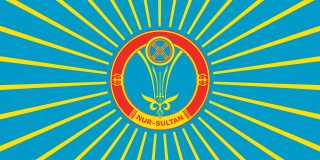
The flag of Nur-Sultan was designed by the President of Kazakhstan, Nursultan Nazarbayev. The flag was adopted along with the coat of arms of Nur-Sultan at the 16th session of the Maslikhat of Astana.
The city now known as Nur-Sultan was founded by a unit of the Siberian Cossacks headed by Fyodor Shubin in 1830 as the settlement of Akmoly.

The Day of the Capital City of Kazakhstan is an official public holiday in Kazakhstan. It was established in 2009 and is celebrated on July 6 to celebrate the capital city of Kazakhstan, Nur-Sultan. The holiday also coincides with the birthday of ex-President Nursultan Nazarbayev.

Kazakhstan–Qatar relations are the bilateral relations between the Republic of Kazakhstan and the State of Qatar. Diplomatic relations were established in 1993. Kazakhstan has an embassy in Doha. Qatar has an embassy in Nur-Sultan.

Kazakhstan–Mongolia relations describes bilateral diplomatic relations between Mongolia and the Republic of Kazakhstan. Mongolia established diplomatic relations with the Republic of Kazakhstan on January 22, 1992.
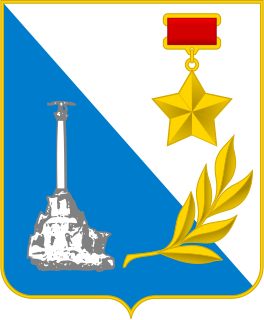
The coat of arms of Sevastopol is a heraldic symbol representing the city of Sevastopol, Crimea. It is featured in the middle of the Flag of Sevastopol on a red background.
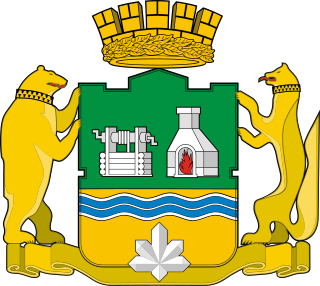
The coat of arms of Yekaterinburg is the official municipal coat of arms of Yekaterinburg, Russia. The current symbol was adopted on 23 May 2008 and consists of a French shield divided horizontally into two fields, with a white mine shaft and a white furnace within the top field, which is green, and a blue wavy bend within the bottom field, which is gold. A gold bear and gold sable are located to the left and right of the shield, respectively. A gold crown with a gold laurel wreath is located above the shield and a gold ribbon is located below the shield. A grey druse is located at the bottom center of the shield.

The coat of arms of Perm is the official municipal coat of arms of Perm, Russia. The current design, adopted on 9 June 1998, features a red field with a silver bear with a yellow Bible resting on its back and a white four-pointed star above. The design is very similar to the coat of arms of Perm Krai.

The Nur-Sultan City Mäslihat is a unicameral legislature of Kazakhstan’s capital city of Nur-Sultan. The councillors of the City Mäslihat are elected concurrently with the MP's of the Mazhilis. The City Mäslihat councillors perform their duties by approving plans, economic and social programs for the city's development.

Pavel Olegovich Kazantsev is a Kazakh politician currently serving as the Deputy Chair of the Mazhilis since 15 January 2021 and as Mazhilis member since 2016.

Ashat Razdyquly Oralov is a Kazakh politician serving as the Executive Secretary of Amanat since 2 February 2022.























